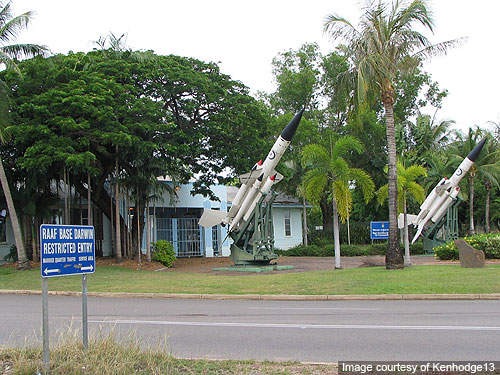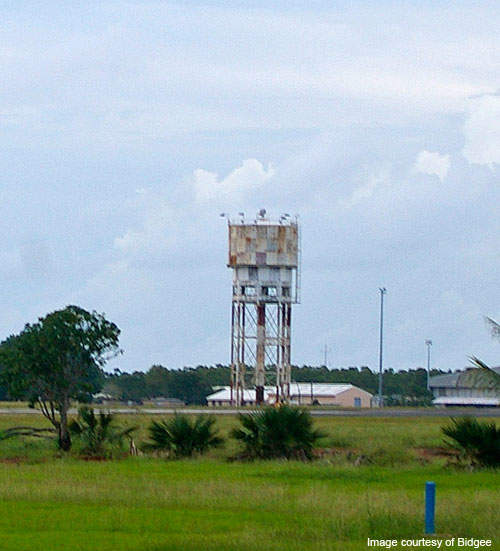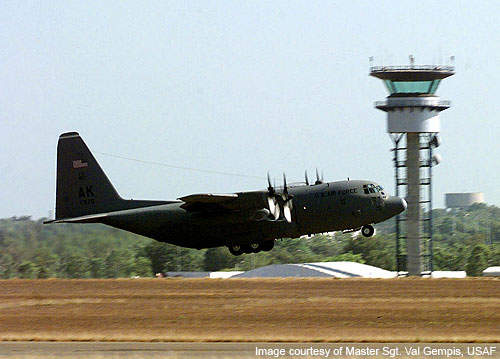Royal Australian Air Force Base Darwin (YPDN) is a military training base situated 6km north-east of Darwin in Australia. The base was opened in June 1940 and shares its runway with the nearest Darwin International Airport. The base is owned and operated by the Royal Australian Air Force (RAAF).YPDN executes emergency landing for NASA Space Shuttles on its long runway.
History
The development of the RAAF base Darwin began in 1938. The base became operational in June 1940 with the relocation of an airfield from its original site to Darwin. The base acted as the first refuge to bring back United States Army Air Force (USAAF) units from the Philippines in 1941. The No.12 Squadron deployed in Parap Airfield was shifted to Darwin in April 1941. Aircraft including V Fighter and V Bomber were deployed at the base in December 1941. Japanese Forces demolished a few buildings in the base during two major air raids in February 1942.
The Distinguished Unit Citation (DUC) was launched at the base in August 1943 to attack the oil plant, shipping and dock facilities located in Balikpapan, Borneo. The DUC continuously attacked enemy airfields of Western New Guinea from April to May 1944. Four Squadrons of B-24 Liberator bombers which belong to 380th Bombardment Group were stationed at the base from August 1944 to February 1945. A major expansion was carried out in the base in the 1950’s. The expansion included construction of the main runway, taxiway and a military apron system.
Other developments which took place in the 1970’s include explosives storage, fuel storage and operational, technical and domestic amenities. The domestic and administrative buildings of the base were badly damaged in 1974 due to Cyclone Tracy.
Renovation of married quarters, new explosive ordnance, security facilities, and new air traffic control facilities were completed in the early 1990’s.
The Australian government decided to redevelop the RAAF Base Darwin in two stages at a cost of $49.8m. Stage 1 began in 1997 to rectify the shortfalls of the previous construction works at the base.
The Stage 1 works included building a new airfield fire station, extra fuel storage, a base command post, central emergency power station and ordnance loading aprons. The construction works of Stage 1 were completed in early 2005.
Design and construction
The Stage 2 redevelopment will correct the deficiencies of Stage 1. The design phase of Stage 2 began in September 2008. Work on Stage 2 encompasses construction of a single storey structure, which features office space, conference rooms, secure operations areas, ablutions, amenities and parking.
It also involves construction of a mechanical workshop, fuel tanker wash bay and a new fuel farm, and consociated reticulation. The base is expected to create 50 jobs during its peak construction. The Stage 2 redevelopment is expected to be completed by September 2011.
Garrison facilities
The base serves as headquarters for No. 44 wing detachment Darwin and No. 92 wing detachment Darwin. The No. 396 expeditionary combat support wing is also sheltered in the base and provides combat and support services to the Australian Air Force bases.
The base is also home to No. 13 squadron, No. 1 air terminal squadron detachment Darwin, No 3 combat support hospital detachment Darwin. No. 114 mobile control and reporting unit is RAAF’s radar unit principally used during military exercises.
Air facilities
The base features two runways (11/29 and 18/36) surfaced with asphalt. The lengths of the two runways are 3,354m and 1,524m respectively. The YPDN can accommodate F-35 joint strike fighters to perform training operations.
It also conciliates C-130 Hercules, V Fighter, V Bomber, and B-24 Liberator long range bomber aircraft.
No. 44 wing detachment Darwin which is owned by Surveillance and Response Group operates 11 air traffic control (ATC) stations across Australia.
The wing also renders ATC technical ground electronic services (GES) to the base. It also offers radar control services to the Australian Defence Force (ADF).
The ATC station tracks and alerts the base operators when foreign aircraft fly in the skies of Australia.
Other facilities
The base offers training, rest rooms, coffee shops, sporting fields, dining facilities, recreation, education, child care and medical care facilities.






